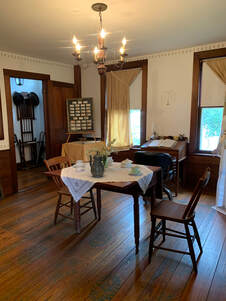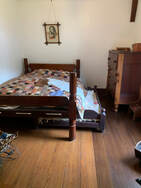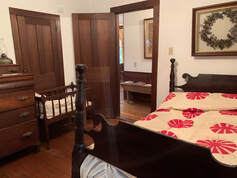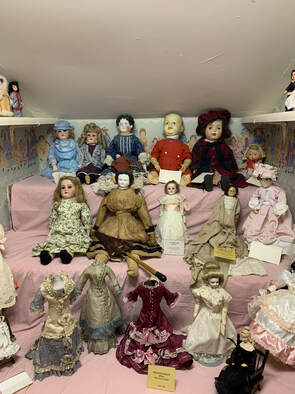The Squire Rich Museum: The 1840s Home
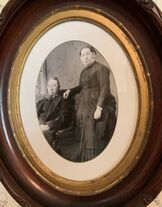
Charles Rich and his wife, Ann Jane, came to Brecksville by ox-team from New Lebanon Springs, on the border of New York and Massachusetts. The journey was made in 1835 and their two daughters Hannah and Lucy were born shortly after arrival. The original property consisted of 100 acres; another 50 or so acres were added later. The land was farmed and the crops included corn, wheat, potatoes, and turnips. Farm animals were also raised.
Around 1842, the house was built. Originally the house had four rooms downstairs and four rooms upstairs. Later a porch, a shed, and a summer kitchen were added. Back in the days before air-conditioning, farmhouses would often have a separate building (a summer kitchen) where they would cook meals, preserve garden-fresh produce, and bake goodies. Having a separate building meant the women would heat the main house while the food was being prepared.
The house cost $600 (paid in cash) to build. The floors were made of ash; the woodwork, doors and wainscoting were black walnut. Lumber for the home came from the trees on property that now is part of Lubrizol, on Brecksville Road. The lumber was prepared by a local sawmill using power from Chippewa Creek.
Charles Rich served as a Justice of Peace for 30 years in Brecksville Township. This occupation was the source of his “title” of Squire. His duties included performing marriages and settling land disputes as well as dealing with criminal cases involving horse and cattle thievery. The family home was also his place of business.
Ann Jane Rich not only carried out her duties as a farmer’s wife and mother, but was an expert seamstress as well as a practicing herbalist. The herb garden at the house attests to her use of herbs for both medical and culinary purposes. Her tailoring expertise can be viewed in Holland Snow’s wedding coat, on display in the museum.
Ann Jane died in 1882; the Squire a year later. Hannah Rich Kettlewell then lived in the house until her death 1905; her son, Charles Kettlewell lived there until his death 1941. In 1921, the property was acquired by the Cleveland Metroparks, Brecksville Reservation. It has been Cleveland Metroparks property since then. The house is maintained as a museum by the Brecksville Historical Association.
Around 1842, the house was built. Originally the house had four rooms downstairs and four rooms upstairs. Later a porch, a shed, and a summer kitchen were added. Back in the days before air-conditioning, farmhouses would often have a separate building (a summer kitchen) where they would cook meals, preserve garden-fresh produce, and bake goodies. Having a separate building meant the women would heat the main house while the food was being prepared.
The house cost $600 (paid in cash) to build. The floors were made of ash; the woodwork, doors and wainscoting were black walnut. Lumber for the home came from the trees on property that now is part of Lubrizol, on Brecksville Road. The lumber was prepared by a local sawmill using power from Chippewa Creek.
Charles Rich served as a Justice of Peace for 30 years in Brecksville Township. This occupation was the source of his “title” of Squire. His duties included performing marriages and settling land disputes as well as dealing with criminal cases involving horse and cattle thievery. The family home was also his place of business.
Ann Jane Rich not only carried out her duties as a farmer’s wife and mother, but was an expert seamstress as well as a practicing herbalist. The herb garden at the house attests to her use of herbs for both medical and culinary purposes. Her tailoring expertise can be viewed in Holland Snow’s wedding coat, on display in the museum.
Ann Jane died in 1882; the Squire a year later. Hannah Rich Kettlewell then lived in the house until her death 1905; her son, Charles Kettlewell lived there until his death 1941. In 1921, the property was acquired by the Cleveland Metroparks, Brecksville Reservation. It has been Cleveland Metroparks property since then. The house is maintained as a museum by the Brecksville Historical Association.
A Quick Tour of the Museum:
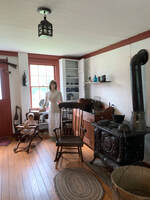
The Brecksville Historical Association has maintained the historic house as a museum since 1961. In 1996, a burst water pipe caused extensive damage of over $36,000. Once repairs were made, a re-dedication ceremony was held in 1997. The Museum is listed on the National Register of Historic Places and can be visited on most Sundays from mid-May to mid-October from 2-5 p.m, as shown on the Calendar. Tours can also be arranged by appointment.
Six rooms can be viewed on a tour of the Squire Rich House. Tours enter via the back porch into the Summer Kitchen. This must have been a busy place – this is where canning and other food preservation took place as well as food preparation and baths. There is a wood-burning cook stove as well as a variety of kitchen implements. The yoke used to bring water in from the well and cistern is on display, as well as the wood box and wooden tub.
According to Squire Rich’s granddaughter, there was no dry sink, the dishes were washed in a pan on the Pantry shelf and the water poured out the window or down a drain in the kitchen. At the Museum the pantry shelves now display a collection of irons, ironstone china and other kitchen utensils.
Six rooms can be viewed on a tour of the Squire Rich House. Tours enter via the back porch into the Summer Kitchen. This must have been a busy place – this is where canning and other food preservation took place as well as food preparation and baths. There is a wood-burning cook stove as well as a variety of kitchen implements. The yoke used to bring water in from the well and cistern is on display, as well as the wood box and wooden tub.
According to Squire Rich’s granddaughter, there was no dry sink, the dishes were washed in a pan on the Pantry shelf and the water poured out the window or down a drain in the kitchen. At the Museum the pantry shelves now display a collection of irons, ironstone china and other kitchen utensils.
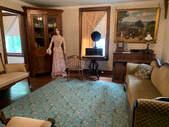
The Parlor is now the Museum’s exhibit room. This is the room where the Squire married couples. It was also used by the family for company, and funerals.
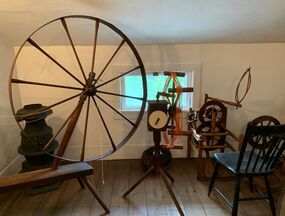 Spinning wheels
Spinning wheels
The Upstairs Bedroom contains items that might have been found in a mid-19th century child's bedroom. Other rooms upstairs contain collections of artifacts that have been donated to the Brecksville Historical Association. One very special collection includes dolls....a French Fashion Doll, a "Door of Hope" Chinese doll carved from Niponga wood, and a Kewpie doll, popular in the late 19th and early 20th centuries. There are stories attached to all of them!
This is only a brief description of what you might see if you toured the Museum. Why not join us on a summer Sunday afternoon?
